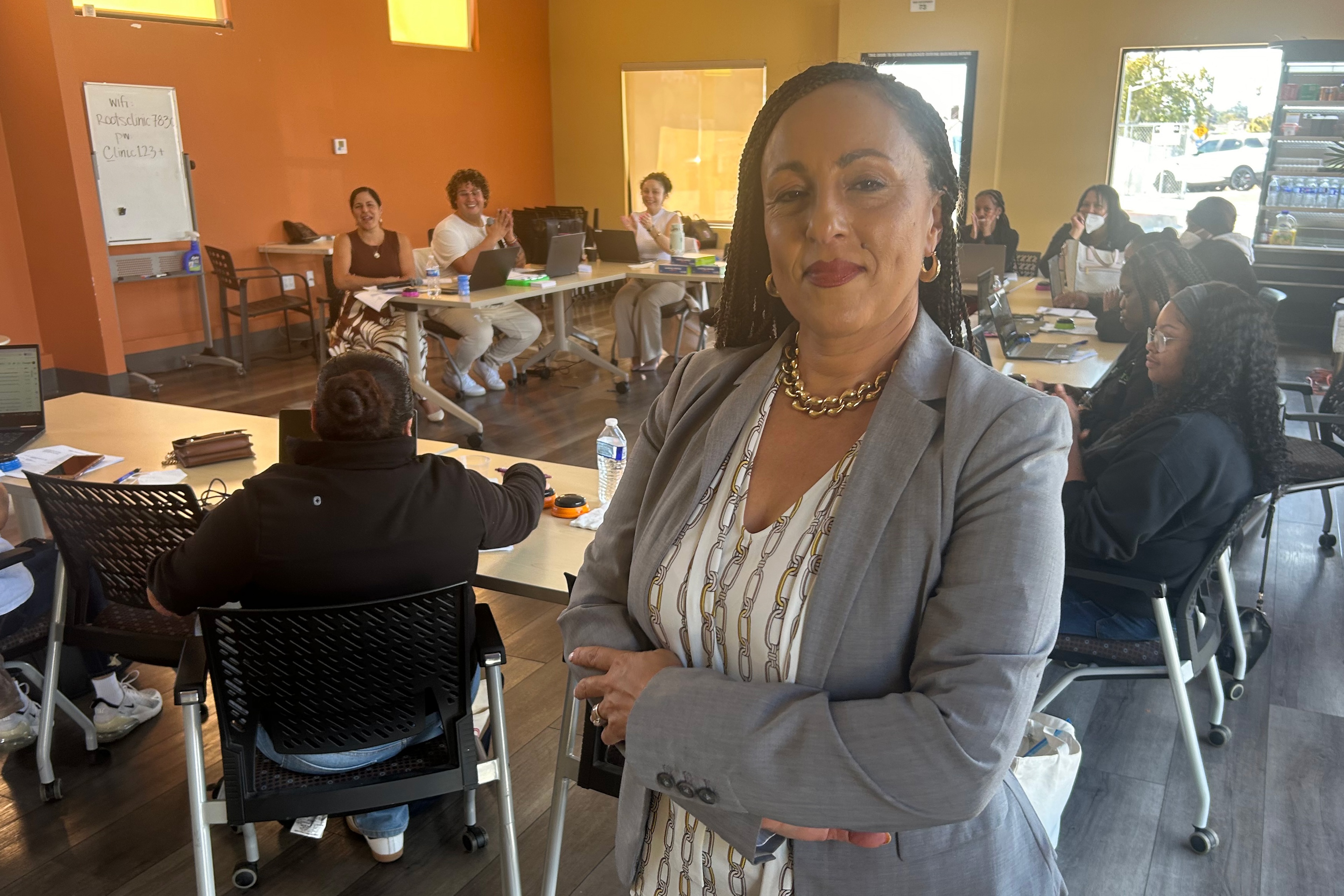OAKLAND, Calif. — The affected person was in his 60s, an African American man with emphysema. The oximeter positioned on his fingertip registered properly above the 88% blood oxygen saturation degree that alerts an pressing danger of organ failure and loss of life.
But his physician, Noha Aboelata, believed the affected person was sicker than the machine confirmed. So she despatched him for a lab check, which confirmed her suspicion that he wanted supplemental oxygen at dwelling.
Months later, in December 2020, Aboelata thought again to her affected person as she learn a New England Journal of Drugs article exhibiting that pulse oximeters had been 3 times as doubtless to overlook dangerously low blood oxygen ranges in Black sufferers as in white ones. At a time when Black Individuals had been dying of covid at excessive charges and hospitals struggled to search out beds and oxygen for these needing them, the discovering uncovered probably the most blatant examples of institutional racism in American well being care.
“I was like, ‘Were there other patients I missed?” mentioned Aboelata, a household doctor and the CEO of Oakland-based Roots Group Well being. As she shared the article with colleagues, “there was so much anger and frustration because we had every reason to believe we could rely on this device, and it was systematically not working in the population that we served.”
State attorneys basic and U.S. senators have pressed the FDA to take steps to remove pulse oximetry’s racial bias, which has precipitated delays in remedy and worse well being outcomes, and extra lately has raised concern in regards to the reliability of hospital AI instruments that draw on reams of knowledge from the units.
Aboelata’s clinic has sued producers and shops that promote oximeters, demanding they pull the units or add security warnings to the labels. Lots of her sufferers depend on dwelling oxygen, which requires correct readings for Medicare to cowl.
However eliminating the units, central to take care of coronary heart and lung ailments, sleep apnea, and different situations, isn’t an possibility.
Because the Nineties, the handy fingertip clamps have come to face in for a lot of makes use of of arterial blood gasoline readings, that are the gold commonplace for figuring out oxygen ranges however harmful if not carried out fastidiously. Makers of oximeters will promote round $3 billion of them this yr as a result of they’re utilized in practically each hospital, clinic, and long-term care facility. Throughout the pandemic, tons of of 1000’s of Individuals purchased them for dwelling use.
One among them was Walter Wilson, a 70-year-old businessman in San Jose who has had two kidney transplants since 2000. Wilson contracted covid final December however delayed visiting a physician as a result of his dwelling pulse oximetry readings had been within the regular vary.
“I’m a dark-complected Black guy. I was very sick. Had the oximeter picked that up I would have gotten to the hospital sooner,” he mentioned.
Wilson ended up again on dialysis after a number of years of fine well being. Now he’s seeking to be a part of a category motion lawsuit towards the machine producers.
“They’ve known for years that people with darker skin get bad readings,” he mentioned, “but they tested them on healthy white people.”
After years of little motion on the problem, the FDA in 2021 despatched a security warning to medical doctors about oximeters. It has additionally funded analysis to enhance the units and promised to concern new tips for how one can make them.
However because the FDA polishes draft tips it had hoped to publish by Oct. 1, clinicians and scientists are not sure what to anticipate. The company has indicated it’s going to advocate that producers check new oximeters on extra folks, together with a big share with dark-pigmented pores and skin.
Due to {industry} pushback, nonetheless, the steerage isn’t anticipated to ask machine makers to check oximeters beneath real-world situations, mentioned Michael Lipnick, a College of California-San Francisco anesthesiologist and researcher.
Hospitalized individuals are typically dehydrated, with restricted blood circulate to their extremities. This situation, often known as low perfusion — basically, poor circulation — is especially frequent with heart problems, which is extra prevalent in Black sufferers.
Pigmentation and poor perfusion “work together to degrade pulse oximetry performance,” mentioned Philip Bickler, who directs the Hypoxia Analysis Lab at UCSF. “During covid, Black patients showed up sicker because of all the barriers those patients face in accessing health care. They’re showing up on death’s door, and their perfusion is lower.”
The FDA steerage isn’t anticipated to require producers to measure how properly their units carry out in sufferers with poor perfusion. All which means that the FDA’s efforts might result in units that work in wholesome dark-skinned adults however do “not fix the problem,” mentioned Hugh Cassiere, who chairs a panel for the FDA’s Medical Gadgets Advisory Committee, at its February assembly.

A Historical past of Inaction
Though some current industry-sponsored research have proven that sure units work throughout pores and skin tones, analysis relationship to the Nineteen Eighties has discovered discrepancies in pulse oximetry. In 2005, Bickler and different scientists on the Hypoxia Lab revealed proof that three main units persistently did not detect hypoxemia in darkly pigmented sufferers — particularly those that had been severely oxygen-depleted. Noting that these readings might be essential to directing remedy, the authors known as for oximeters to hold warnings.
The FDA’s response was modest. Its regulatory pathway for pulse oximeters clears them on the market so long as they present “substantial equivalence” to units already available on the market. In a 2007 draft steerage doc, the FDA recommended that exams of latest oximeters might “include a sufficient number of subjects with dark skin pigmentation, e.g., 30%.” Nevertheless, the ultimate steerage, issued in 2013, advisable “at least 2 darkly pigmented subjects or 15% of your subject pool, whichever is larger.” The research had been required to have solely 10 topics. And the company didn’t outline “dark-pigmented.”
Testing the units includes becoming sufferers with masks that management the gases they breathe, whereas concurrently taking pulse oximetry readings and samples of arterial blood which might be fed right into a extremely correct measuring machine, invented by the Hypoxia Lab’s late founder, John Severinghaus.
Bickler, who evinces the bemused skepticism of a seasoned automobile mechanic when discussing the scores of units his lab has examined, mentioned “you can’t always trust what the manufacturers say.”
Their information, he mentioned, ranges from “completely inaccurate” to “obtained under absolutely ideal conditions, nothing like a real-world performance.”
Throughout the pandemic, a medical charity approached the lab about donating 1000’s of oximeters to poor international locations. The oximeters it had chosen “weren’t very good,” he mentioned. After that, the lab arrange its personal rankings web page, a form of Shopper Experiences for pulse oximeters.
In line with its exams, some costly units don’t work; a number of of the $35 devices are more practical than rivals costing $350. Over a 3rd of the marketed units the lab has examined don’t meet present FDA requirements, in accordance with the location.
To research whether or not real-world exams of oximeters are possible, the FDA funded a UCSF research that has recruited about 200 intensive care unit sufferers. The info from the research is being ready to bear peer assessment for publication, Bickler mentioned.
He mentioned the lab didn’t heat the arms of sufferers within the research, which is the customary follow of producers once they check their units. Warming assures higher circulation within the finger the machine is connected to.
“It affects the signal-to-noise ratio,” Bickler mentioned. “Remember when car radios had AM stations, and you’d get a lot of static? That’s what poor perfusion does — it causes noise, or static that can obscure a clear signal from the device.”
Hypoxia Lab scientists — and medical doctors in the true world — don’t heat sufferers’ arms. However “the industry people can’t agree on how to handle it,” he mentioned.
Masimo, an organization that claims it has probably the most correct pulse oximeters available on the market, would fortunately adjust to any FDA steerage, Daniel Cantillon, Masimo’s chief medical officer, mentioned in an interview.
How A lot To Repair the Downside?
The perfect units, in accordance with the Hypoxia Lab, value $6,000 or extra. That factors to a different drawback.
With higher accuracy, “you are going to reduce patient access to devices for a large proportion of the world that simply can’t afford them,” Lipnick mentioned.
Even when the FDA can’t please everybody, its anticipated name for extra folks with darker pores and skin in oximetry exams will “assure there’s real diversity in the development and testing of those devices before they come to market,” Lipnick mentioned. “That bar has been too low for decades.”
It’s tough to evaluate hurt to people from defective oximeter readings, as a result of these errors are sometimes one consider a sequence of occasions. However research at Johns Hopkins College and elsewhere indicated that sufferers whose oxygen depletion wasn’t seen — probably 1000’s of them — had delayed remedy and worse outcomes.
Already, Aboelata mentioned, a number of producers — Zewa Medical Know-how, Veridian Healthcare, and Gurin Merchandise — have responded to the Roots Group Well being lawsuit by together with warnings about their units’ limitations.
There’s not a lot she and different clinicians can do in day by day follow, she mentioned, apart from set up a baseline studying with every new affected person and be looking out for notable drops. Hospitals produce other instruments to examine oxygen ranges, however right readings are crucial for outpatient care, she mentioned. In 2022, Connecticut enacted a regulation banning insurers from denying dwelling oxygen or different providers based mostly solely on pulse oximetry readings.
However “adapting around the crappy device isn’t the solution,” mentioned Theodore Iwashyna, the Johns Hopkins Bloomberg College of Public Well being professor who co-authored the New England Journal of Drugs article. “A less crappy device is the solution.”




